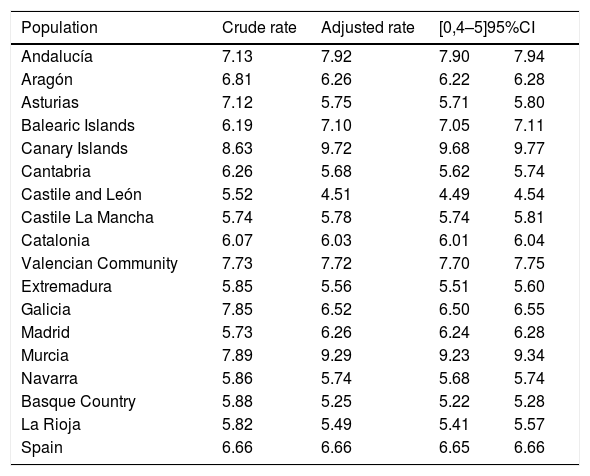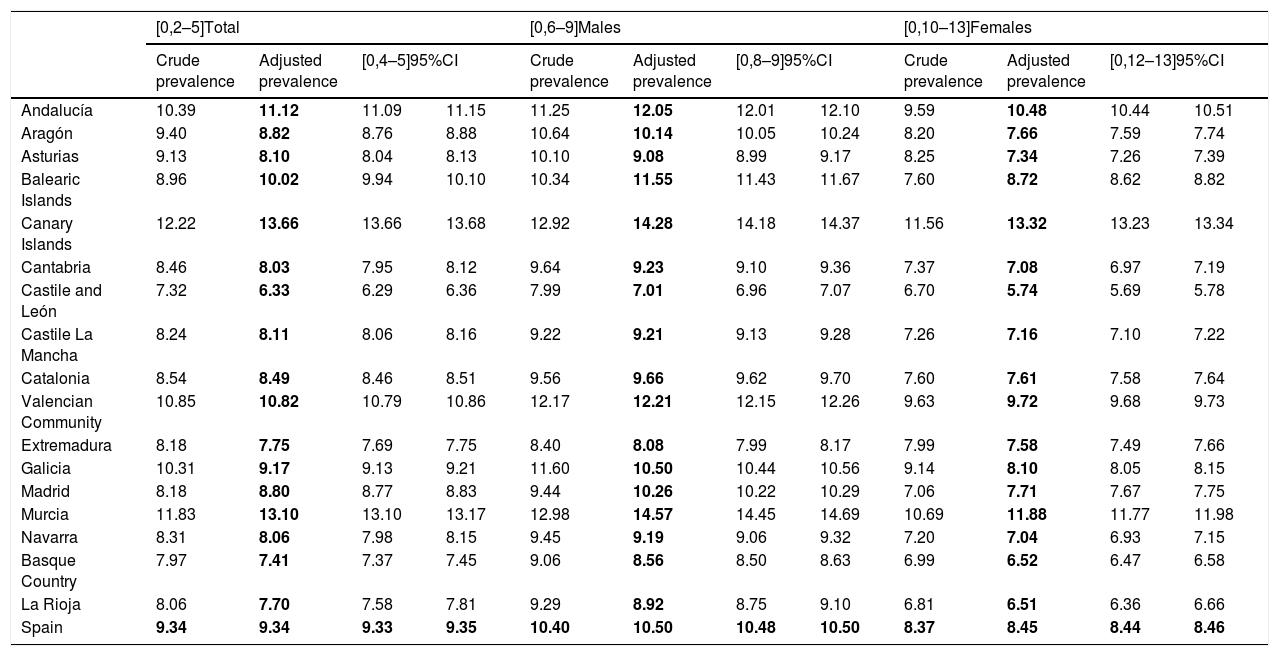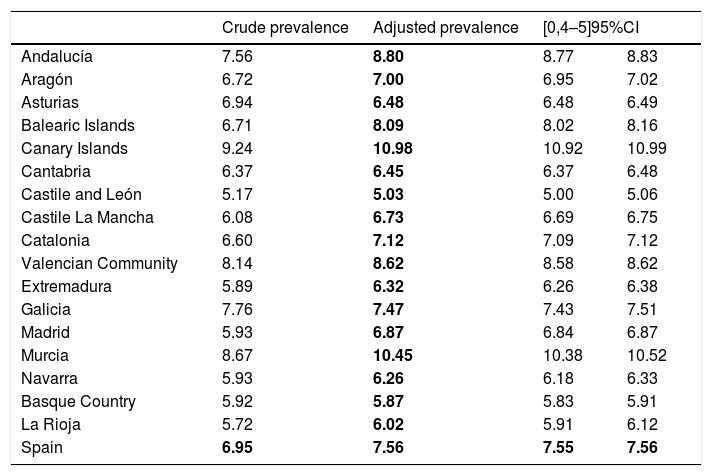The prevalence of type 2 diabetes mellitus is increasing worldwide, including in Spain, and this disease has become a major challenge for health care. In Spain, the computerization of medical records in primary care, in the Primary Care Clinical Database (BDCAP), has made possible the diagnoses of diabetes in a representative sample of the nation as a whole. This article analyzes the prevalence of diabetes recorded in this database and compares the data of the different autonomous communities (ACs).
The prevalence of diabetes in Spain is 6.66% of the total population assigned to primary care in the National Health System, is higher in men than in women (7.27% vs. 6.06%), and increases with age up to 80 years.
There are significant differences in the adjusted prevalence of diabetes between ACs, with lower prevalence rates in North and Central Spain and higher rates in the South and East, as well as the islands. The lowest prevalence is seen in Castile and León (4.51%), and the highest in the Canary Islands (9.72%).
La prevalencia de la diabetes tipo 2 está aumentando en todo el mundo incluido nuestro país, convirtiéndose en un enorme reto para la atención sanitaria. En España la informatización de la historia clínica en la Atención Primaria nos ha permitido disponer de los diagnósticos de diabetes de una muestra representativa de todo el territorio nacional, la Base de Datos Clínicos de Atención Primaria (BDCAP). En este trabajo se analiza la prevalencia de diabetes en esta base de datos y se compara la existente en las distintas comunidades autónomas (CCAA).
La prevalencia de diabetes en España es del 6,66% de la población total asignada a la Atención Primaria del Sistema Nacional de Salud, es mayor en hombres que en mujeres (7,27% vs 6,06%) y aumenta con la edad hasta los 80 años de edad.
Se observan unas diferencias importantes para las prevalencias ajustadas de diabetes entre unas CCAA y otras, siendo la prevalencia menor en las regiones del norte y centro de la península y mayor en el Sur y Este así como en las islas. La prevalencia más baja se observa en Castilla y León (4,51%) y la más alta en las Islas Canarias (9,72%).
The prevalence of diabetes is increasing worldwide, similarly to that of obesity, and is reaching levels that constitute a genuine challenge for healthcare systems. According to the International Diabetes Federation (IDF), 451 million adults suffer from diabetes, and by the year 2045 this figure is expected to increase to 693 million, though with substantial differences among regions.1
Knowledge of the prevalence of diabetes is essential for determining the allocation of resources and to guide health and disease prevention policies, for in addition to its multiple complications, the disease is associated with increased mortality.2
In Spain, the progressive digitalization of health systems in primary care centres and the use of diagnostic coding systems have made possible the compiling of data corresponding to 2016 that are representative of all people diagnosed with diabetes in the country.
The purpose of the present study was to determine the prevalence of diagnosed diabetes compiled from primary care records in Spain and to analyse regional differences within the country, as well as the characteristics of the affected individuals in terms of age and gender.
MethodsThe Primary Care Clinical Database (Base de Datos Clínicos de Atención Primaria [BDCAP]) of the Spanish National Health System has been developed for statistical and research purposes, with the consensus of all the Autonomous Communities (ACs) in the country and the National Institute of Health Management (Instituto Nacional de Gestión Sanitaria [INGESA]). The database annually collects standardized clinical information on the care provided at primary care level based on a large random sample (approximately 10%) of the medical records of the population assigned to that level of care, and is representative of each Spanish Autonomous Community.3
Data from people with the health problem coded as T89 (insulin-dependent diabetes) or T90 (non-insulin-dependent diabetes) in 2016 were extracted from the BDCAP from all the ACs, and by gender and 5-year age intervals.
For comparisons between ACs in Spain, prevalence was adjusted by the direct method to the Spanish population of that year according to the National Institute of Statistics (Instituto Nacional de Estadística [INS]), stratified by age and gender.
Taking into account the available data, and in order to establish comparisons by gender and among all the ACs, only data from people over 29 years of age in all ACs were considered.
For a comparative analysis with other European countries, the prevalence was adjusted to the standardized European population of 20134 at 5-year intervals and using the direct method.
ResultsIn 2016, a total of 2,956,121 people were diagnosed with diabetes in Spain, representing 6.66% of the population of the above-mentioned age assigned to primary care in the Spanish National Health System (44,721,909 people; 96.25% of the Spanish population of 46,450,975 in that year according to the National Institute of Statistics).5 The prevalence adjusted to the European population was 6.77%.
As shown in Table 1 and graphically displayed by the map in Fig. 1, there were substantial differences in the crude and the adjusted prevalences of the Spanish population between some ACs and others in the country. The adjusted prevalence rates ranged from 4.51% in Castilla y León to 9.72% in the Canary Islands.
Prevalence (crude and adjusted to the Spanish population [%]) of diagnosed diabetes mellitus in Spain and its Autonomous Communities in 2016.
| Population | Crude rate | Adjusted rate | [0,4–5]95%CI | |
|---|---|---|---|---|
| Andalucía | 7.13 | 7.92 | 7.90 | 7.94 |
| Aragón | 6.81 | 6.26 | 6.22 | 6.28 |
| Asturias | 7.12 | 5.75 | 5.71 | 5.80 |
| Balearic Islands | 6.19 | 7.10 | 7.05 | 7.11 |
| Canary Islands | 8.63 | 9.72 | 9.68 | 9.77 |
| Cantabria | 6.26 | 5.68 | 5.62 | 5.74 |
| Castile and León | 5.52 | 4.51 | 4.49 | 4.54 |
| Castile La Mancha | 5.74 | 5.78 | 5.74 | 5.81 |
| Catalonia | 6.07 | 6.03 | 6.01 | 6.04 |
| Valencian Community | 7.73 | 7.72 | 7.70 | 7.75 |
| Extremadura | 5.85 | 5.56 | 5.51 | 5.60 |
| Galicia | 7.85 | 6.52 | 6.50 | 6.55 |
| Madrid | 5.73 | 6.26 | 6.24 | 6.28 |
| Murcia | 7.89 | 9.29 | 9.23 | 9.34 |
| Navarra | 5.86 | 5.74 | 5.68 | 5.74 |
| Basque Country | 5.88 | 5.25 | 5.22 | 5.28 |
| La Rioja | 5.82 | 5.49 | 5.41 | 5.57 |
| Spain | 6.66 | 6.66 | 6.65 | 6.66 |
A total of 53.49% of the people with diabetes (1,592,095) were males and 46.51% were females (1,384,185). The crude prevalence in males was 7.27%, which was significantly higher (P < .001) than in females (6.06%).
The prevalence was higher from 30 years of age onwards, and increased as age progressed to 80 years, followed by a decrease (Fig. 2). In all age groups the prevalence was higher in males than in females up until 80 years of age (Table 2), and then proved similar in both genders beyond that age.
Prevalence (crude and adjusted [%]) of diagnosed diabetes mellitus in Spain and its Autonomous Communities in 2016, in individuals aged 30 years or older (adjusted to the Spanish population).
| [0,2–5]Total | [0,6–9]Males | [0,10–13]Females | ||||||||||
|---|---|---|---|---|---|---|---|---|---|---|---|---|
| Crude prevalence | Adjusted prevalence | [0,4–5]95%CI | Crude prevalence | Adjusted prevalence | [0,8–9]95%CI | Crude prevalence | Adjusted prevalence | [0,12–13]95%CI | ||||
| Andalucía | 10.39 | 11.12 | 11.09 | 11.15 | 11.25 | 12.05 | 12.01 | 12.10 | 9.59 | 10.48 | 10.44 | 10.51 |
| Aragón | 9.40 | 8.82 | 8.76 | 8.88 | 10.64 | 10.14 | 10.05 | 10.24 | 8.20 | 7.66 | 7.59 | 7.74 |
| Asturias | 9.13 | 8.10 | 8.04 | 8.13 | 10.10 | 9.08 | 8.99 | 9.17 | 8.25 | 7.34 | 7.26 | 7.39 |
| Balearic Islands | 8.96 | 10.02 | 9.94 | 10.10 | 10.34 | 11.55 | 11.43 | 11.67 | 7.60 | 8.72 | 8.62 | 8.82 |
| Canary Islands | 12.22 | 13.66 | 13.66 | 13.68 | 12.92 | 14.28 | 14.18 | 14.37 | 11.56 | 13.32 | 13.23 | 13.34 |
| Cantabria | 8.46 | 8.03 | 7.95 | 8.12 | 9.64 | 9.23 | 9.10 | 9.36 | 7.37 | 7.08 | 6.97 | 7.19 |
| Castile and León | 7.32 | 6.33 | 6.29 | 6.36 | 7.99 | 7.01 | 6.96 | 7.07 | 6.70 | 5.74 | 5.69 | 5.78 |
| Castile La Mancha | 8.24 | 8.11 | 8.06 | 8.16 | 9.22 | 9.21 | 9.13 | 9.28 | 7.26 | 7.16 | 7.10 | 7.22 |
| Catalonia | 8.54 | 8.49 | 8.46 | 8.51 | 9.56 | 9.66 | 9.62 | 9.70 | 7.60 | 7.61 | 7.58 | 7.64 |
| Valencian Community | 10.85 | 10.82 | 10.79 | 10.86 | 12.17 | 12.21 | 12.15 | 12.26 | 9.63 | 9.72 | 9.68 | 9.73 |
| Extremadura | 8.18 | 7.75 | 7.69 | 7.75 | 8.40 | 8.08 | 7.99 | 8.17 | 7.99 | 7.58 | 7.49 | 7.66 |
| Galicia | 10.31 | 9.17 | 9.13 | 9.21 | 11.60 | 10.50 | 10.44 | 10.56 | 9.14 | 8.10 | 8.05 | 8.15 |
| Madrid | 8.18 | 8.80 | 8.77 | 8.83 | 9.44 | 10.26 | 10.22 | 10.29 | 7.06 | 7.71 | 7.67 | 7.75 |
| Murcia | 11.83 | 13.10 | 13.10 | 13.17 | 12.98 | 14.57 | 14.45 | 14.69 | 10.69 | 11.88 | 11.77 | 11.98 |
| Navarra | 8.31 | 8.06 | 7.98 | 8.15 | 9.45 | 9.19 | 9.06 | 9.32 | 7.20 | 7.04 | 6.93 | 7.15 |
| Basque Country | 7.97 | 7.41 | 7.37 | 7.45 | 9.06 | 8.56 | 8.50 | 8.63 | 6.99 | 6.52 | 6.47 | 6.58 |
| La Rioja | 8.06 | 7.70 | 7.58 | 7.81 | 9.29 | 8.92 | 8.75 | 9.10 | 6.81 | 6.51 | 6.36 | 6.66 |
| Spain | 9.34 | 9.34 | 9.33 | 9.35 | 10.40 | 10.50 | 10.48 | 10.50 | 8.37 | 8.45 | 8.44 | 8.46 |
The crude prevalence of diabetes in the population between 20–79 years of age was 6.95%, versus 7.56% adjusted to the European population of the same age (Table 3).
Prevalence (crude and adjusted [%]) of diagnosed diabetes mellitus in Spain and its Autonomous Communities in 2016, in individuals aged 20–79 years or older (adjusted to the European population).
| Crude prevalence | Adjusted prevalence | [0,4–5]95%CI | ||
|---|---|---|---|---|
| Andalucía | 7.56 | 8.80 | 8.77 | 8.83 |
| Aragón | 6.72 | 7.00 | 6.95 | 7.02 |
| Asturias | 6.94 | 6.48 | 6.48 | 6.49 |
| Balearic Islands | 6.71 | 8.09 | 8.02 | 8.16 |
| Canary Islands | 9.24 | 10.98 | 10.92 | 10.99 |
| Cantabria | 6.37 | 6.45 | 6.37 | 6.48 |
| Castile and León | 5.17 | 5.03 | 5.00 | 5.06 |
| Castile La Mancha | 6.08 | 6.73 | 6.69 | 6.75 |
| Catalonia | 6.60 | 7.12 | 7.09 | 7.12 |
| Valencian Community | 8.14 | 8.62 | 8.58 | 8.62 |
| Extremadura | 5.89 | 6.32 | 6.26 | 6.38 |
| Galicia | 7.76 | 7.47 | 7.43 | 7.51 |
| Madrid | 5.93 | 6.87 | 6.84 | 6.87 |
| Murcia | 8.67 | 10.45 | 10.38 | 10.52 |
| Navarra | 5.93 | 6.26 | 6.18 | 6.33 |
| Basque Country | 5.92 | 5.87 | 5.83 | 5.91 |
| La Rioja | 5.72 | 6.02 | 5.91 | 6.12 |
| Spain | 6.95 | 7.56 | 7.55 | 7.56 |
The prevalence of diabetes in Spain has been estimated from either national epidemiological studies such as the di@bet.es study6 conducted in 2010, or data from the national health survey.7
The present study with data from 2016 reports the prevalence of diagnosed diabetes in the population assigned to the public health services throughout Spain, representing practically the entire population of the country (96.25%). The crude prevalence of diabetes is 6.66% of the total Spanish population, which in the population aged 20–79 years is 7.56% when adjusted to the European population. This prevalence is similar to that recently documented in Portugal8 and is considerably higher than the diagnosed diabetes rates in other countries such as France,9 Ireland,10 Italy11 and Norway.12
The data from the national health survey with information reported by the participants shows a gradual increase in the prevalence of diabetes in recent years. In 2012, the prevalence among individuals over 15 years of age was 7.4% (adjusted to 7.1%),7 which is similar to that found in our study.
In the di@bet.es study, the prevalence of diabetes was 13.8% among individuals 18–89 years of age, and diabetes was diagnosed in 7.8% of that population.6 This prevalence was similar to that seen in other southern European countries such as Portugal,13 but notably higher than that recorded in northern European countries.14 It was also very similar to that reported in our study, perhaps indicating a stabilization of the prevalence in recent years.
The di@bet.es study lacked the statistical power to differentiate prevalence among the different zones of Spain, though the prevalence of diabetes in Andalusia was seen to be much higher than in the rest of the country, as was the prevalence of obesity and a sedentary lifestyle.15 Other regional studies have reported a prevalence of diagnosed diabetes lower than that observed in our study, though the data were from earlier years.16,17 In the Canary Islands, the prevalence of confirmed diabetes was already as high as 9% in 2005,18 and this prevalence has recently been found still to be higher than that of the rest of Spain.19
For the first time we can compare the regional differences in the crude and adjusted prevalence of diagnosed diabetes. These differences are very substantial between some parts of Spain and others. The crude prevalence ranges from 5.52% in Castilla y León to 8.63% in the Canary Islands. However, on comparing the adjusted rates, these figures undergo significant changes due to the different degrees of population aging in the various ACs. In this regard, the map shows that in northern and central Spain the adjusted prevalence is under 6%, with the exception of Madrid. In the south of the country this prevalence ranges from 6% to 8%. However, there are two regions with a prevalence above 9%: Murcia (9.29%) and the Canary Islands (9.72%).
The explanation for these differences may be found in the differences in the obesity rates, since different studies have shown the frequency of obesity and abdominal obesity in Spain to be higher in the Canary Islands and in the southern and eastern regions of the country,20,21 such as Andalusia,15 in concordance with the prevalence of diabetes found in our study.
As in all developed countries, most people diagnosed with diabetes are over 50 years of age,14 and in the concrete case of Spain this age group accounts for over 90% of all people with diabetes.
The prevalence of diabetes was higher in men than in women. This finding is consistent with the results of the European Health Examination Pilot Project.22 The gender difference may be due to the fact that men develop diabetes at lower levels of abdominal obesity than women. Previous studies on adipose tissue distribution, insulin resistance, sex hormones and blood glucose levels between males and females have corroborated this hypothesis.23
As in many other publications, a limitation of our study is the fact that no differentiation could be made between type 1 and type 2 diabetes mellitus; however, type 2 diabetes accounts for over 90% of all cases of diabetes, and our results therefore mainly reflect type 2 diabetes.
In conclusion, the present study estimates the prevalence of diagnosed diabetes in the National Health System to be 6.66% of the total population. The disease is more common in men, and increases in frequency up to 80 years of age. The differences between ACs are very important, with generally a lower prevalence in the north and central parts of the country and a higher prevalence in the east and south, with the highest levels being recorded in the Canary Islands.
Financial supportThe present study has received no funding.
Conflicts of interestThere are no conflicts of interest in relation to the present study.
Please cite this article as: Menéndez Torre EL, Blanco JA, Barreiro SC, Martínez GR, Alvarez ED. Prevalencia de diabetes mellitus en 2016 en España según la Base de Datos Clínicos de Atención Primaria (BDCAP). Endocrinol Diabetes Nutr. 2021;68:109–115.













